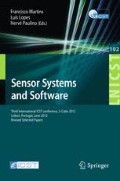Abstract
Wireless sensor networks (WSNs) can be widely used for managing various scenarios existing in social, industrial and numerous environmental management systems. They have been widely used in environmental monitoring and management applications and have also found application in disaster management scenarios. One of the greatest problems faced by the scientific community in organizing data collection through sensor networks in areas of disaster is the disorder and destruction brought about in the communication systems prevailing in such situations. In this paper, a scientific study of the various scenarios that could occur post-disaster and the various housekeeping functions each sensor node would adopt as part of the self management requirement is provided. We also present a sensor task management framework that could be implemented to provide a low energy consuming, reliable network for WSNs deployed for critical infrastructure management.
Access this chapter
Tax calculation will be finalised at checkout
Purchases are for personal use only
Preview
Unable to display preview. Download preview PDF.
References
Frye, L.: Network management of a wireless sensor network, pp. 1–13 (2007)
Lotf, J.J., Hosseinzadeh, M., Alguliev, R.M.: Hierarchical routing in wireless sensor networks: a survey. In: 2010 2nd International Conference on Computer Engineering and Technology, pp. V3-650–V3-654 (2010)
Zheng, J., Jamalipour, A.: Wireless sensor networks: a networking perspective, vol. 2008, p. 489. Wiley-IEEE Press (2009)
Wang, C., Sohraby, K., Hu, Y., Li, B., Tang, W.: Issues of transport control protocols for wireless sensor networks. In: Proceedings of 2005 International Conference on Communications, Circuits and Systems, pp. 422–426 (2005)
Sitanayah, L., Sreenan, C.J., Brown, K.N.: ER-MAC: A Hybrid MAC Protocol for Emergency Response Wireless Sensor Networks. In: 2010 Fourth International Conference on Sensor Technologies and Applications (SENSORCOMM), pp. 244–249 (2010)
Ali, M., Böhm, A., Jonsson, M.: Wireless Sensor Networks for Surveillance Applications – A Comparative Survey of MAC Protocols. In: 2008 The Fourth International Conference on Wireless and Mobile Communications, pp. 399–403 (2008)
Cantoni, V., Lombardi, L., Lombardi, P.: Challenges for Data Mining in Distributed Sensor Networks. In: 18th International Conference on Pattern Recognition (ICPR 2006), pp. 1000–1007 (2006)
Aguilar-Ponce, R., McNeely, J., Baker, A., Kumar, A., Bayoumi, M.: Multisensor Data Fusion Schemes for Wireless Sensor Networks. In: 2006 International Workshop on Computer Architecture for Machine Perception and Sensing, pp. 136–141 (September 2007)
Chen, Y., Shu, J., Zhang, S., Liu, L., Sun, L.: Data Fusion in Wireless Sensor Networks. In: 2009 Second International Symposium on Electronic Commerce and Security, pp. 504–509 (2009)
Gengzhong, Z., Qiumei, L.: A Survey on Topology Control in Wireless Sensor Networks. In: 2010 Second International Conference on Future Networks, pp. 376–380 (2010)
Frye, L., Bigrigg, M.W.: Topology Maintenance of Wireless Sensor Networks in Node Failure-prone Environments. In: 2006 IEEE International Conference on Networking, Sensing and Control, vol. 15213, pp. 886–891 (2006)
Younis, M., Akkaya, K.: Strategies and techniques for node placement in wireless sensor networks: A survey. Ad Hoc Networks 6(4), 621–655 (2008)
Asim, M., Yu, M., Mokhtar, H., Merabti, M.: A Self-Configurable Architecture for Wireless Sensor Networks. In: 2010 Developments in E-systems Engineering, pp. 76–81 (September 2010)
Pogkas, N., Karastergios, G.E., Antonopoulos, C.P., Koubias, S., Papadopoulos, G.: Architecture design and implementation of an ad-hoc network for disaster relief operations. IEEE Transactions on Industrial Informatics 3(1), 63–72 (2007)
Cayirci, E., Coplu, T.: SENDROM: Sensor networks for disaster relief operations management. Wireless Networks 13(3), 409–423 (2006)
Gopalakrishnan Nair, N., Morrow, P.J., Parr, G.P.: Design Considerations for a Self-Managed Wireless Sensor Cloud for Emergency Response Scenario. In: The 12th Annual Post Graduate Symposium on the Convergence of Telecommunications, Networking and Broadcasting, PGNet 2011 (2011)
Author information
Authors and Affiliations
Editor information
Editors and Affiliations
Rights and permissions
Copyright information
© 2012 ICST Institute for Computer Science, Social Informatics and Telecommunications Engineering
About this paper
Cite this paper
Nair, N.G., Morrow, P.J., Parr, G.P. (2012). Framework for a Self-managed Wireless Sensor Cloud for Critical Event Management. In: Martins, F., Lopes, L., Paulino, H. (eds) Sensor Systems and Software. S-CUBE 2012. Lecture Notes of the Institute for Computer Sciences, Social Informatics and Telecommunications Engineering, vol 102. Springer, Berlin, Heidelberg. https://doi.org/10.1007/978-3-642-32778-0_2
Download citation
DOI: https://doi.org/10.1007/978-3-642-32778-0_2
Publisher Name: Springer, Berlin, Heidelberg
Print ISBN: 978-3-642-32777-3
Online ISBN: 978-3-642-32778-0
eBook Packages: Computer ScienceComputer Science (R0)

